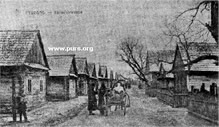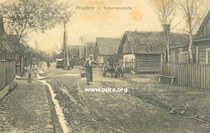PRUZHANY HISTORY
Pruzzeneh --- Pruz'any --- Pruzhany --- IIPYXAHbI ---
The POMERANTZ and SAFER families came from Eastern Europe. The POMERANTZ’s were from Kamenets-Litovsk, not to be confused with Kamanets-Podolsk, and the SAFER’s were from what was then Pruzzeneh and is now Pruzhany. Both towns were in the Grodno Gebernah - an administrative district in Poland.
Pruz’any was a Jewish community located in what was once the Brisk district of Lithuania. It is situated on the road leading from Brest-Litovsk to Moscow. This area is today called Belorussia or Belarus.
The Fifteenth Century
In the mid-1400's, Pruz'any was governed by the Lithuanian State Committee. The first synagogue was built in the Jewish quarter in 1463. In 1495, all Jews were expelled from Lithuania, including the Jewish people in Pruz'any. Some returned a few years later and by 1563 there were twenty-two Jewish families in the town. Most earned their livelihood from agriculture and raising livestock while a few engaged in commerce and crafts. Five year later, the Jews in Pruz'any were granted the right to live in accordance with their religious beliefs. The first mention of Jewish merchants in the town registry was in 1583.
The Seventeenth Century
Iin 1644, now under Polish rule, King Wadyslar granted Jews the rights to engage freely in their occupations. They were permitted to buy houses and plots in the market square and town streets; sell wine, ale, mead; and deal in workshops and trades. Jews were exempt from paying taxes on synagogue lands and cemeteries. In addition to having the right to practice their religion, Jews could now construct synagogues, provided they were not built like Christian churches. Six years later, King Jan Kazimierz reaffirmed the main privileges but banned the purchase of new land for building synagogues.
By the end of the seventeenth century, there were 571 Jews in Pruz'any. By 1766, those twenty-two families of a century earlier had grown to 641 people, comprising more than forty percent of the townspeople. In 1795, Poland was partitioned for the third time and Pruz'any was incorporated into Russia. By the turn of the century, Pruz'any was a regional center with 1,285 Jews. Interestingly, some of these were Karaites, a Jewish sect founded in the Middle Ages that opposed the Talmud.
The Nineteenth Century
The Jewish population continued to grow. In 1847 there were 2,583 Jews in the district. Tragedy struck in 1863 when the very first synagogue burned to the ground. In spite of this, through the end of the 19th century, the Pruz'any Jewish community enjoyed a vigorous social and cultural life. The Jewish community continued to grow and by 1921 reached 4,152, despite the emigration of many Jews to the United States. (Many of our ancestors had come to America by then.)
The Twentieth Century
In 1927, almost sixty percent of the population in Pruz'any was Jewish, and sixteen of the twenty-four delegates elected to the municipal government were Jews.
The War Years (1934 - 1941)
Under the Soviet Union from 1934 to 1941, Jewish communal bodies were disbanded, cooperatives were established, and educational institutions were reorganized. When war broke out between Russia and Germany in June 1941, the Germans took control of the area. They immediately exacted a fine from the Jewish community of 500,000 rubles, two kilograms of gold and ten kilograms of silver to be paid within twenty-four hours. By September 1941, the Germans had set up a Jewish ghetto and soon all the Jews from the surrounding area were herded into it.
Within a few months, a Jewish underground formed a resistance organization in the ghetto. They made contact with the local partisans in the surrounding forests. The organization was soon disbanded after being discovered by the Germans. The deportations to Auschwitz began in January 1943. Some resistance members were able to escape and join the Jewish partisans in the forests, however, within four days, the Jewish community was destroyed.
After the War
By the late 1960's, there were twelve Jewish families left in Pruzhany. The great synagogue had been turned into an electric power plant.
Note: The above, excerpted, modified and condensed, was reproduced without (!) the permission of the United Pruzana and Vicinity Relief Committee from their book, "Pinkas Pruz'any and Its Vicinity," subtitled, "Chronical of Six Communities Perished in the Holocaust", Tel Aviv 1983.
ÜFor additional information about Pruzhany and the Holocaust read: Pinkas Pruzhany and its Vicinity. NOTE: Parts of this book are available online at: http://freepages.genealogy.rootsweb.com/~cpsa/pinkas1983/cover_page.htm
WAS THE PRUZHANY DISTRICT IN RUSSIA OR POLAND?
The PRUZHANY DISTRICT was in Poland until 1795 when Prussia (Germany), Austria and Russia each took chunks of Poland. At that time the PRUZHANY DISTRICT became part of the Russian Empire until World War I. During some parts of World War I the Germans occupied the PRUZHANY DISTRICT. After World War I, and until the end of World War II, the PRUZHANY DISTRICT returned to Poland. After World War II the PRUZHANY DISTRICT was once again in Russia, until the collapse of the Soviet Union in 1991, when Belarus became a sovereign state.
Location: Lat. 52'33 Long. 24'28
Distances (1 mile = 1.6 km)
|
Pruzany |
Shershov |
Lineve |
Bereza |
Malch |
Seltz |
Pruzany |
----- |
16.9 km |
7.7 km |
28.6 km |
17.4 km |
28.4 km |
Shershov |
16.9 km |
----- |
20.5 km |
29.6 |
49.6 km |
45.3 km |
Lineve |
7.7 km |
20.5 km |
----- |
22.3 km |
13.5 km |
20.5 km |
Bereza |
28.6 km |
29.6 km |
22.3 km |
----- |
20.0 km |
29.6 km |
Malch |
17.4 km |
49.6 km |
13.5 km |
20.0 km |
------ |
49.6 km |
Seltz |
28.4 km |
45.3 km |
28.2 km |
8.7 km |
16.6 km |
----- |
DISCLAIMER: THIS IS WORK IN PROGRESS. WE ARE NOT SURE THIS INFORMATION IS ENTIRELY CORRECT, AND WE KNOW IT IS INCOMPLETE. |


